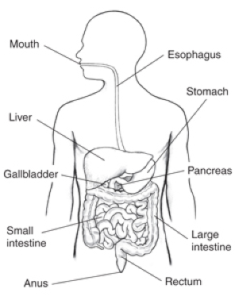Chapter 1: Anatomy & Physiology of Swallowing

The process of swallowing begins when the sensory system first experiences the food or beverage. The visual and olfactory senses combined with past experience with a particular substance, help ready the system for the entry of the food or liquid into the oral cavity. The food or liquid is then prepared into a bolus and transported from the oral cavity through the pharynx and esophagus where it enters into the stomach. At that time, nutrients are extracted from the bolus as it journeys through the small and large intestines. Eventually, the remaining waste is eliminated from the body. This chapter will focus on the anatomy and physiology needed for the safe and efficient passage of food and liquid from the lips to the cervical esophagus.
Learning Objectives
Upon completion, learners will be able to:
- Draw the swallow mechanism
- Describe anatomical differences in the swallowing mechanism across the life span
- Identify oral and pharyngeal muscles important in swallowing
- Describe the physiology of the healthy swallow in infants, children, adults, and geriatric populations
- Define neuroanatomical structures important in swallowing
- Develop a list of key anatomical structures in the oral and pharyngeal cavity that are related to swallowing. Include a brief description of the role that each structure plays in the healthy swallow. Practice drawing the key structures.
- Develop a list of muscles important to swallowing. Indicate their (a) origin and insertion, (b) innervation, and (c) role in swallowing. This is done through completion of Activity 1.1.
- Describe the changes in anatomy across the lifespan. How is infant anatomy different from adult anatomy? What is the impact of advanced age on anatomy?
- Briefly describe how oral saliva is produced and why this is important in swallowing.
- Describe how taste information is coded, interpreted, and received.
- Describe and compare infant signs of feeding readiness versus distress (not ready). What cues may cause you to stop feeding?
- Define infant oral reflexes important for swallowing. Include stimulus and response for each reflex. How does each reflex support feeding and swallowing in healthy infanta?
- Discuss the interaction of respiration and swallowing. Include the phases of respiration.
- Describe nutritive versus non-nutritive suck. Indicate the uses of each.
- List events of oropharyngeal swallowing. Cluster them into an organized framework. Describe your framework. Indicate how the swallow events may change as a function of age.
- Describe the activity of the velum throughout the swallow.
- Describe the opening and closing of the UES throughout the swallow. Be sure to address both active and passive forces that impact UES opening during the swallow.
- Describe aspects of airway protection before, during, and after the swallow.
- List cranial nerves important for swallowing and indicate the role each one plays in the process.
This chapter will cover:
- Anatomy of Swallowing
- Swallow Physiology
- Neurology of Swallowing

